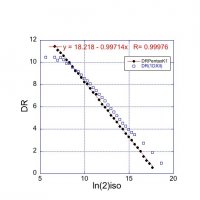I do not believe that it is very easy to determine a sensors ISO-in-variance by looking at the sensors dynamic range.
The same site however does provide charts for what I believe to be an indication of ISO-in-variance. They call it "Photographic Dynamic Range Shadow Improvement versus ISO".
http://www.photonstophotos.net/Gene...ographic_Dynamic_Range_Shadow_Improvement.htm
If I understand correctly, what this chart shows is how much extra shadow detail is gained by increasing the ISO instead of raising an underexposed image in post. In other words whether it is worth using higher ISO's instead of just underexposing and raising in post.
http://www.photonstophotos.net/Charts/PDR_Shadow.htm#Canon EOS 1D X Mark II,Canon EOS 6D Mark II,Nikon D850,Pentax K-1
View attachment 183321
From this chart we can see that basically the closest of the 4 cameras to ISO-in-variance is the Pentax K-1 which only sees about a 0.2EV improvement increasing the ISO over base,
The Nikon D850 is ISO-in-variant above 500, with 500 yielding about a 1EV improvement.
The 1DX MK2 however only appears to see a no significant improvement once we get to about ISO 3200 (1.7 EV improvement). I suppose you could argue that the 0.3EV improvement from 800 to 3200 isn't much.
With the 6D MK2 you can clearly see that using higher ISO's are very beneficial (interestingly you can also easily see where the analogue gain is used and where the digital gain is used).
I also believe the preceding chart illustrates that the only camera of the ones I picked only the Pentax conforms to Tony Northrup's ideas (I must confess I didn't watch the video I just read the summary provided). Clearly if we look at something like the 6D2 the ISO setting (at least the full stops) has a big difference and works as you would expect although increasing ISO by one stop only gives you about 0.8EV extra sensitivity.
The quote by Jrista provided by AlanF is 100% correct. I just thought I could expand a bit on what increasing the ISO in camera actually does. As mentioned the signal coming off the sensor is an analogue signal so it needs to be read by an analogue to digital converter (ADC) which quantizes the signal (converts an analogue voltage into a digital number between 0 and 2^14 for a 14-bit ADC). This process introduces noise. If we then amplify the signal after this (raise in post or digital ISO) we also increase the magnitude of the noise thus we don't get as much improvement as we expected. One way around this is to amplify the signal before the ADC reads it, this reduces the headroom but normally improves the signal to noise ratio so as long as you are not clipping highlights it should be an improvement.
If the noise introduced by the ADC is negligible and the ADC has sufficient bit depth we can theoretically do all amplification digitally without any adverse effects, this would be a perfect ISO-in-variant sensor. The introduction of the low noise on sensor ADC's has definitely reduced the need for pre-amplification or perhaps eliminated it completely with certain cameras. I suspect the Pentax K-1 either has such good ADC's that it doesn't benefit from them or it doesn't actually have them (I think the latter is more likely since that would explain why the 1DX MK2 has better dynamic range at ISO's over 800).
http://www.photonstophotos.net/Charts/PDR.htm#Canon EOS 1D X Mark II,Pentax K-1


